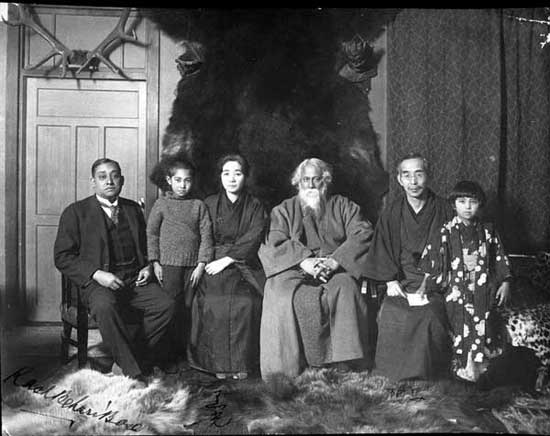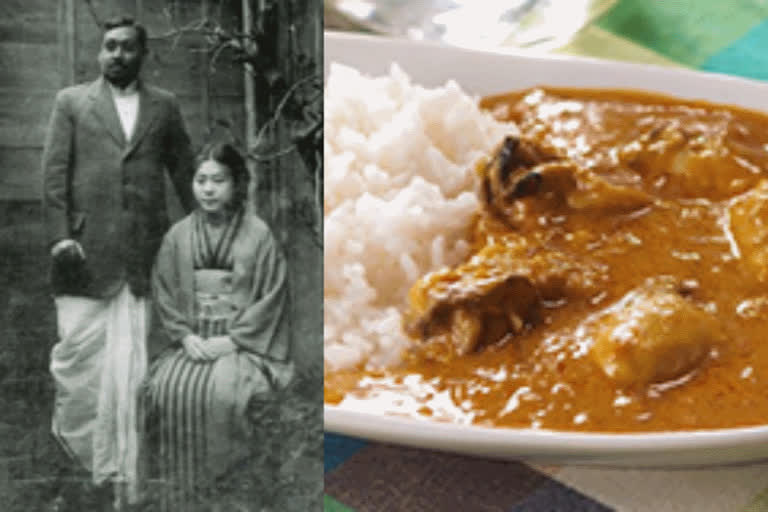Kolkata (West Bengal): There is hardly any connection between the small hamlet of Suboldaha along the Damodar River in Purba Bardhaman district of West Bengal with that of the glitz of Tokyo in Japan. But, a close peek at the history books and India’s freedom movement will lead you to the inevitable connection between the two diverse geographical locations - the connection of soil.
One of the torch bearers of the country’s freedom movement, Rash Behari Bose was more of Toyko’s, than of Suboldaha where he was born. Bose’s role in the freedom struggle remains relatively unknown in popular history. However, the unique dish, known as Indo-curry, that he introduced remains immensely popular in his adopted home.
Bose’s journey from Kolkata to Tokyo
In 1889, following the death of his mother, a three-year-old child was raised by his maternal aunt and uncle. Later, a young Rash Behari went to college in Chandernagore and then to Dehradun, where he took up a job at the Forest Research Institute. Job apart, Bose was more into revolutionary ideas and he fled Kolkata in 1908 to avoid arrest in the Alipore Bomb case.
Then came 1912. Rash Behari Bose put his plan to action at Delhi’s Chandni Chowk area, by trying to kill then Viceroy Lord Hardinge by throwing a bomb at his carriage. Hardinge narrowly escaped, but Lala Vasant Roy, Basanta Kumar Biswas, Bal Mukund, Amirchand and Awadh Bihari were caught. All others, except Lala Vasant, were hanged. Rash Behari fled and went underground.
The developments were happening quickly now. Rash Behari even tried to engineer a couple of mutinies in the British Army, but failed. By then, he was one of the most wanted men by the British.

On consultation among close quarters, Rash Behari decided to flee India.
On June 8, 1915, a bespectacled man, Priyanath Bose, arrived at the docks of Kobe, Japan alighted from the ship. The man, then took a train to Tokyo. Settling down, the new Rash Behari Bose got in touch with another nationalist, Sun Yat-Sen. The local police arranged for his stay in Tokyo and Rash Behari began planning about what he believed in - overthrowing the British from India. He kept sending arms from Japan to his Indian contacts for revolutionary purposes. By the time, he had got in touch with famous Japanese politician Mitsuru Toyama.
The British were also not sitting idle. Eventually word got out that Priyanath Bose in Tokyo was none other than their Most Wanted - Rash Behari Bose. Diplomatic parleys to hand over Bose to the British, however, failed. Mitsuru knew that Rash Behari was exposed and he had to flee. The Nakamuraya bakery run by the famous Soma family in Shinzuku province was the best choice. Mitsuru arranged for a studio apartment behind the bakery where Rash Behari and his comrade in arms, Herambalal Gupta could stay.
Birth of Indo-curry
As time passed, this Nakamuraya bakery became an inseparable part of Bose’s life. Though he had been touring many parts of Japan, yet his closeness to Kokko, the owner of the bakery and the Soma family only grew. Eventually, he married Toshiko, Kokko’s eldest daughter on July 9, 1919. Hounded by British sleuths, the couple had to frequently change dwellings. Amid those turbulent times, Toshiko and Rash Behari had two children, a boy and a girl in 1920 and 1922. But, after three years of giving birth to her second child, Toshiko died at the age of 28, suffering from pneumonia.
A devastated Rash Behari, plunged more into nationalistic activities. He formed the Indian Club to extend active help to all revolutionaries engaged in giving the British, a run for their money. Then came the Indian Independence League in 1942. The following year, another person alighted from a German U-Boat in Tokyo, all the way from Berlin. It was Subhash Chandra Bose.
Also read: AP govt suspends TTD decision to auction 50 immovable properties of Tirumala temple
Rash Behari finally found his match and handed over the reins of the Indian National Army to Subhas Chandra.
Amid all these developments, an interesting thing happened in Rash Behari’s charismatic life. He had opened a small restaurant on the first floor of the Nakamuraya bakery to lend a helping hand to his father-in-law. That was where he first introduced a recipe, which had a close semblance with the Indian curry.
With the presence of bones in chicken and the hot and sweet spice laced curry served along with steaming rice, it didn't go down well with the Japanese initially. But, once they got used to the taste, there was hardly any looking back. The Indo-curry proudly found its permanent place in Nakamuraya’s menu in 1927. And it still is there, unputdownable.
On January 21, 1945, an ailing Rash Behari breathed his last at the age of 58. While undergoing treatment, when doctors had once asked him what he would like to have, Bose had nonchalantly said, the nurses are not serving me what I like most - the Indo-curry of Nakamuraya.
Nakamuraya had started its processed food division in 2016, but Rash Behari’s Indo-curry has been made available in ready-to-eat packs since 2001.
Much time has passed, but every time a person enters Nakamuraya to dine, a dhoti-clad bespectacled Rash Behari Bose can be seen standing alongside his wife Toshiko dressed in kimono in a black and white photograph giving the impression that the duo is keeping a close watch on the recipe of the Indo-curry, the unputdownable dish which hasn’t changed since 1927.



